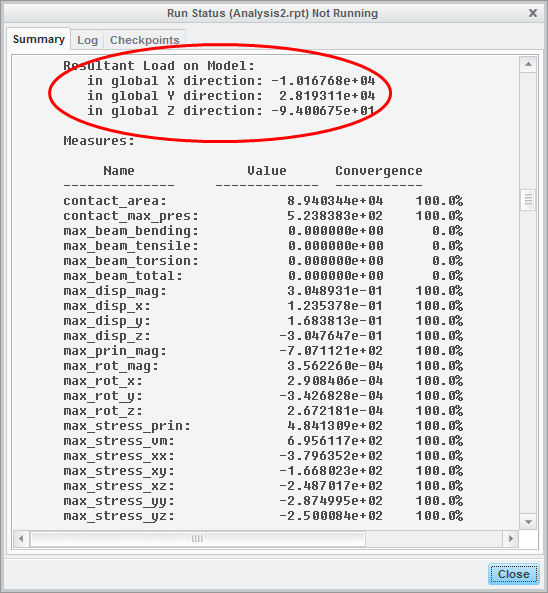Community Tip - New to the community? Learn how to post a question and get help from PTC and industry experts! X
- Community
- Creo+ and Creo Parametric
- System Administration, Installation, and Licensing topics
- Global resultants and time steps
- Subscribe to RSS Feed
- Mark Topic as New
- Mark Topic as Read
- Float this Topic for Current User
- Bookmark
- Subscribe
- Mute
- Printer Friendly Page
Global resultants and time steps
- Mark as New
- Bookmark
- Subscribe
- Mute
- Subscribe to RSS Feed
- Permalink
- Notify Moderator
Global resultants and time steps
Hi,
Following on from Unecessarily repeated first time step
As part of QA we use the Global resultants in the *rpt file to check load balances.
This is particularly important in the 2 cases where
- inertial loads are applied as these cannot be 'previewed' using the REVIEW TOTAL LOAD function
- pressure loads are applied to complicated surfaces where it may be easier to miss a surface or two (not withstanding the less refined integration of pressure when using REVIEW TOTAL LOAD)

We match these numbers together with measures against freebody diagrams.
These useful numbers appear at the end of a design study.
If one uses timesteps then these numbers appear only after the last timestep.
These global resultants are missing from ALL intermediate timesteps.
I have looked in the familiar *.res file but no joy.
There are no measures I can create.
How can Simulate be persuaded to produce these numbers for each timestep?
Is there a development config option?
Is this another enhancement request?
Thanks
This thread is inactive and closed by the PTC Community Management Team. If you would like to provide a reply and re-open this thread, please notify the moderator and reference the thread. You may also use "Start a topic" button to ask a new question. Please be sure to include what version of the PTC product you are using so another community member knowledgeable about your version may be able to assist.
- Labels:
-
General
- Mark as New
- Bookmark
- Subscribe
- Mute
- Subscribe to RSS Feed
- Permalink
- Notify Moderator
Hi Charles,
I do not know if there is a config option to obtain this output for all load steps. If someone filed an enhancement request for this, I would guess it will take a decade until it will be implemented because of the limited resources currently available at PTC's Simulate R&D after PTC top management laid the engine group in California off.
Anyway, I think what you could do is that you may use two measure types for this, as long as the structure is constrained:
- You may use reaction forces at constraints – the global forces applied must appear as reaction force at the constraints, and these measures should be output for every time step (so you may detect unbalanced forces with this)
- If you use constraints in cylindrical or spherical coordinate systems, or Cartesian coordinate systems not in line with the WCS, the constraint reaction forces don’t work (a functionality gap existing since introduction of the product in 1991). In this case, you may alternatively fix the structure e.g. with help of a simple rigid link, where one point is fixed to a ground spring with high numbers (e.g. 1e10 N/mm) on the main diagonal elements in those directions that shall be constrained (note not to use coupling terms in advanced springs, these create wrong reaction forces and wrong modal behavior, see SPR 4714483, so just use the main diagonal elements and Auto Coupling).
Note option b) offers another advantage: You may also read out unbalanced moments in the spring, the global resultants in the rpt file just address unbalanced forces! And – spring forces are also supported in dynamic analysis, whereas constraint forces (and for sure resultant forces) are not as far as I remember (please correct if I’m wrong).
The problem may be if you run a static analysis with inertia relief where no constraints are applied. The only way I currently see is that you constrain the structure with a weighted link and a ground spring. You will see all unbalanced forces/moments in this spring and can apply balancing translational and rotational accelerations by reading out the reaction forces/moments in this spring and compute these required balancing accelerations with help of the mass/inertia Tensor and COG printed out in the report file. You may also make the spring diagonal elements very soft, then you see huge rigid body displacements if your structure is not correctly balanced.
Does this answer your question?
Best,
Roland
- Mark as New
- Bookmark
- Subscribe
- Mute
- Subscribe to RSS Feed
- Permalink
- Notify Moderator
Thanks for that Roland,
I think we probably do most of that
Constraint reactions measures (moments and forces) are applied every time as part of a model build; I don't know why these are part of the natural output. Who wouldn't want to check these?
... and I think I had a bit a moan on this forum about the functionality gap you mention.
I didn't know about the SPR and I will look at that.
I've not tried the rigid link method you describe and I will play with that. The default method here tends to use weighted links to ground springs with measures.
I'm not a great fan of inertia relief. When there are intentional inertial loads applied I use mass properties and a spreadsheet to determine the additional components to total global.
So for my 15 loadsteps I do have constraint moments/force reactions and 'balancing spring' components and the loads I have input. I therefore have a load balance in my spreadsheet for each step.
It's always good to see if my expectation matches the output of the software (even if it is only forces). If it doesn't then one of us is wrong.
bfn
Charles





